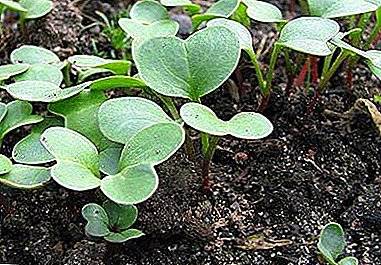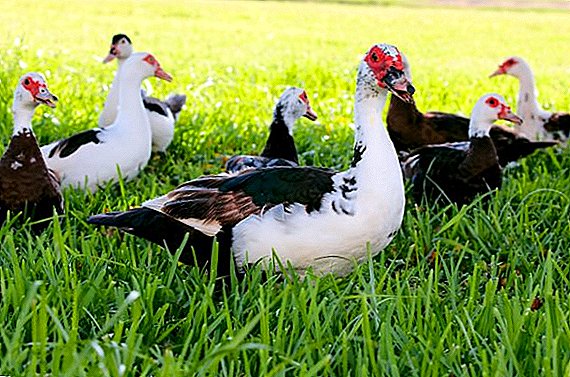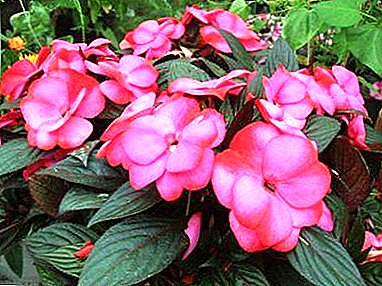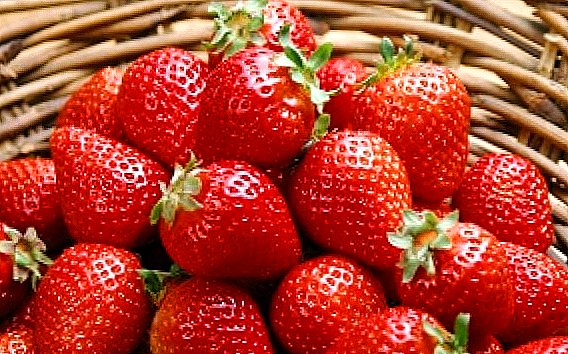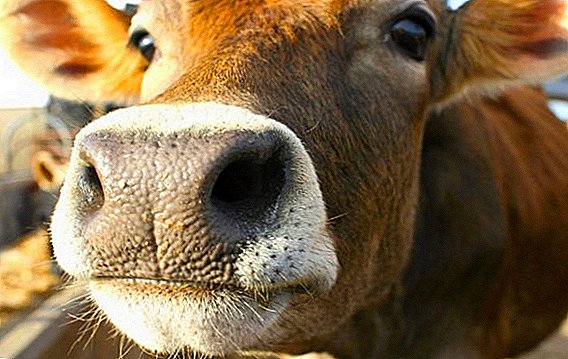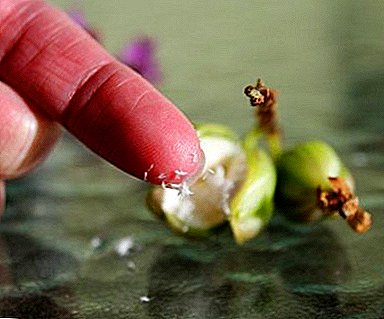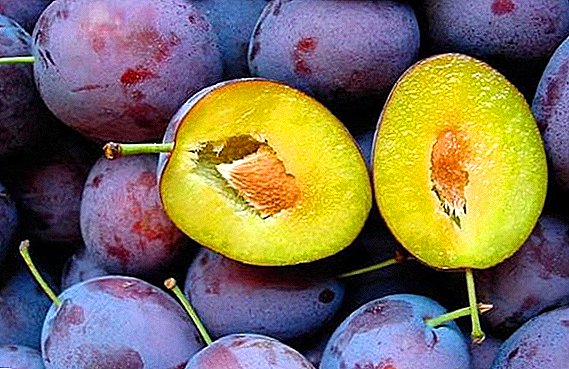 Beautiful and fertile orchard - the dream of every summer resident. Therefore, trees for planting on your site must be carefully selected, so that later there are no unpleasant surprises. Today we will talk about plums, a variety of which is called "President". What the tree looks like, what characteristics distinguish this variety of plums from others, as well as how, where and when to plant a tree and how to care for this variety, you will learn from this article.
Beautiful and fertile orchard - the dream of every summer resident. Therefore, trees for planting on your site must be carefully selected, so that later there are no unpleasant surprises. Today we will talk about plums, a variety of which is called "President". What the tree looks like, what characteristics distinguish this variety of plums from others, as well as how, where and when to plant a tree and how to care for this variety, you will learn from this article.
Tree description
Plum varieties "President" of medium height: the height of the tree, as a rule, does not exceed 3 m. Crohn is round-oval, moderately dense. The tree grows quickly, young shoots first grow high, and only after they are ready to bear fruit, they are pulled parallel to the ground.  The trunks and main branches of the tree with smooth bark, gray-green color. Plum shoots are characterized by moderate thickness, straight shape, the color of their red-brown hue. The size of the lentils is average, there are a lot of them on the increase, the color is white.
The trunks and main branches of the tree with smooth bark, gray-green color. Plum shoots are characterized by moderate thickness, straight shape, the color of their red-brown hue. The size of the lentils is average, there are a lot of them on the increase, the color is white.
The leaves are dark green in color, rounded, pointed at the tip, the main part of the leaf is wide. Plum leaves have a matte finish, a wrinkled surface, and the stipules are characterized by medium size and early abscission. The length of the petioles is medium, the thickness is moderate.
Did you know? In the XIX century, this variety was grown in Great Britain, and specifically in Hertfordshire, which is why "The president" considered native English variety. In European countries, the tree began to spread in the early XX century.
Plum inherent inflorescence with two or three flowers. They differ in large size and similarity in shape with a rose, their color is predominantly white. The formation of fruit ovaries characteristic bouquet branches. 
Fruit Description
Plum fruit varieties "President" are characterized by:
- size - on average, the fruit weighs about 50 g, the maximum weight is 70 g;
- one-dimensionality;
- the rounded shape of the fruit - its tip is rounded, there is a depression at the base, with a wide hole of medium depth;
- the thickness of the skin is medium, it is smooth and has a wax coating. Separating the skin from the plum pulp is difficult;
- the color of the skin of the ripening fruit is green, the ripened color is saturated blue, with an admixture of violet;
- coloring pulp to yellow or greenish-yellow hue. The ripened fruit is moderately resilient;
- the stem is not too thick and moderately long. Breaking a plum from a tree is pretty easy because of this;
- the size of the bones is average, they are oval, elongated, with sharp ends. It is easy to remove a bone from fruit.
 The taste of the fruit is at a high level. The taste of the flesh is delicate, sweetish, with a touch of light sourness, the fruit is juicy. Plum is characterized by the content of such chemicals: ascorbic acid (6.12 mg / 100 g), solids (15.5%), acids (2.46%), sums of sugars (8.5%).
The taste of the fruit is at a high level. The taste of the flesh is delicate, sweetish, with a touch of light sourness, the fruit is juicy. Plum is characterized by the content of such chemicals: ascorbic acid (6.12 mg / 100 g), solids (15.5%), acids (2.46%), sums of sugars (8.5%).Juice from this fruit has no color. Tasters estimate the appearance of the fruit at four points out of five possible. The taste of fresh fruit received four and a half points out of five.
Characteristics of a variety
Variety "President" has characteristics that distinguish this drain from all the others. It is on them that attention should be paid so that getting tasty fruits does not become a burdensome task for you.
Learn about the characteristics of growing varieties of plums such as Mirabel, Bogatyrskaya, Eurasia, Morning, Anna Shpet, Honey White, and peach.It is from the characteristics that you will also learn what measures to take care of the tree must be taken to grow healthy and productive.

Disease and pest resistance
Congenital immunity of the plant to the disease is not. Therefore, the drain will need additional feeding and treatments. Among the diseases that this variety is not terrible, you can select the fungus (its main forms), as well as scab.
Moniliasis rarely affects more than 0.2% of the entire fruit tree, and a plum moth can strike no more than 0.5% of the plum area. There is practically no godetum in this variety. Plum pollinated aphid poses a threat to the tree, but this requires special climatic conditions.
Familiarize yourself with the methods of controlling diseases and pests of the plum, especially with aphids, with a shield.
Drought resistance and winter hardiness
This variety is not terribly hot, dry summer. "President" tolerates such weather conditions. Low temperatures tree also do not harm. Being tested by the conditions of the winter of 1968-1969, the plum froze by only one point, the winter of 1978-1979. caused freezing slightly above three points. 
Pollination
High-quality pollination - the key to a good harvest, so it is important to know the neighborhood with which varieties will have a beneficial effect on the tree and help you get the maximum amount of fruit.
The best pollinators include "Early Reds", "Renklod Altan", "Peace" and "Kuybyshev Ternosliv".
Important! Do not have to plant "The president" next to the varieties listed to collect a large amount of fruit, since the tree itself is characterized by high yields.
In the absence of these varieties, it is possible to place a plum next to Amers, Herman, Joyo, Katinka, Renklod Temple, Vision, Rusch Gesttetter, Opponent or Kabarda Early. All of them are only slightly inferior to the best pollinators and also contribute to good pollination of the tree. 
Terms of flowering and ripening
You can see fragrant flowers on a tree in the middle of May, but the “President” matures late enough - if the summer months are warm, the plums ripen by the second decade of September. Otherwise, you can wait for the fruits by the third decade of September or in October.
Yield
This variety of plum starts to bear fruit quite early - five years after planting you will be able to harvest a crop from a tree. About 17 kg of fruit can be harvested from a young plant up to the age of ten, and from 11 years old, from one plum it will be possible to gather from 20 to 40 kg of fruit.
If you carefully monitor the health of the plant, the yield can reach 70 kg of plums from a single tree.
Transportability
Transporting fruits is not a threat to the quality of the fruit, or their appearance. For this reason, the plum can be grown for sale - it will not lose its presentation during transportation. 
Application
The fruits of this variety are versatile, they can be eaten both fresh and added to various dishes, subjected to processing with high temperatures, frozen or preserved for the winter.
In addition, the fruit can be prepared plum wine, jam, marshmallow, jam, marmalade and cook compote.
You will be interested to know what can be cooked from the plum for the winter, how to marinate, how to make jam, how to cook compote, how to make plum wine, how to dry.
Growing conditions
It is important to choose the most suitable place for the cultivation of plums, then the tree will develop healthy and strong, and therefore will be able to please you with a good harvest.
The first requirement for the planting site is the access of sunlight to the plant. Otherwise, the plum will not receive enough light, which is displayed on the yield of the variety. 
Did you know? Ultraviolet helps to "control" the sugar content of fruits. The more sun a plant receives, the sweeter the harvest will be.
In addition, the terrain should be flat, and also for plum it is necessary to allocate enough space so that other trees do not shade it and do not constrain it. Before you plant a plum tree, you need to pre-level the ground.
In addition, it is necessary to provide air access to the plant. This will help avoid contamination with all sorts of fungal diseases that require moisture to reproduce. The presence of air blowing will allow the tree to dry after excessive watering or rainy season, heavy rains.
The dry climate of the variety tolerates well, however, so that the tree does not dry out, you need to choose the right soil for its development. "President" will approach the land where there is a deep occurrence of groundwater at a depth of about 2 m.  Thus, the root system of the tree will always have access to moisture, and additional watering is required infrequently.
Thus, the root system of the tree will always have access to moisture, and additional watering is required infrequently.
Landing features
Choosing the right place is not everything. You, as well as the planting of a seedling in the ground, you choose only once, after which it will be impossible to move the tree or, moreover, plant it again. It is necessary to pay due attention to this process, so that the drain is fixed in the ground as it should.
The first thing that a gardener faces is seedlings. Before planting, be sure to inspect the planting material and process it if necessary. Slightly dried roots of the seedlings - one of these indications.
In this case, you need to prepare a container with water, where the young cream will spend from 24 to 48 hours. The rhizome can also slightly fade, then use a shears or clippers - be sure to cut off the damaged areas. 
Important! To prevent saplings from getting burns from the fertilizer components, prepare a container with a clay or earthen chatterbox. It is necessary to dip plum rhizome "The president"such a mixture will become a kind of plant protection layer.
Acquire planting material is best in the fall - in late September or early October. The hole in which you subsequently plant the plum can be prepared both in advance (autumn) and two weeks before planting, that is, in the spring season.
Its depth should not exceed half a meter, width - about 75 cm. If you want to plant several drains, then you need to maintain a certain distance between the pits. In the same row between the plums should be a little more than 2 m, between the rows you need to maintain a distance of 4 m.
Then all the trees will have enough space when they grow up.  Do not remove the ground that you dug during the preparation of the fossa. It must be mixed with organic fertilizer - manure or compost, which will need about 20 kg in total. You can also add superphosphate, about 500 g. Soil mixed with fertilizers, fill the pit for plum half.
Do not remove the ground that you dug during the preparation of the fossa. It must be mixed with organic fertilizer - manure or compost, which will need about 20 kg in total. You can also add superphosphate, about 500 g. Soil mixed with fertilizers, fill the pit for plum half.
As an organic fertilizer, you can also use straw, bone meal, fish meal, whey, potato peel, egg shells, banana skins, tobacco dust, onion peel.
When all the preparatory stages are completed, you can proceed to the planting of the tree itself. This is done in the spring, when the earth will thaw a little from the winter cold.
Before you put the seedling in the hole, you need to resort to using a wooden stake of 100 cm in length. One of its ends, which will later be in the ground, you need to sing. This will help prevent possible decay processes in the ground. The peg is placed in such a way that the seedling is on the south side of it.
Did you know? The Queen of England starts each breakfast with two sinks, and then goes directly to the breakfast itself. Plums for Queen Elizabeth II are grown in the garden at the official residence of the monarchs of Holyrood House (Scotland).
 Young plum in an upright position is placed in the hole, gently spreading the roots on the bottom. After that, you can sprinkle the roots with soil. It is important to periodically shake the tree so that the space between the roots does not remain empty, without the earth.
Young plum in an upright position is placed in the hole, gently spreading the roots on the bottom. After that, you can sprinkle the roots with soil. It is important to periodically shake the tree so that the space between the roots does not remain empty, without the earth.Plum root neck should be placed so that it is under the surface of the earth. But not too deep - 2-3 cm will be enough.
A stake is stuck into the ground for a reason; a sapling must be tied to it afterwards. You can remove the peg when the tree becomes an adult, that is, at the age of five.
Sapling plum varieties "President" immediately after planting should be plentifully watered. To do this, you need about 35 liters of water. After watering, it is necessary to prodate the ground around the trunk, half a meter in diameter. To do this, you can take sawdust, grass or earth. The thickness of the mulch, as a rule, is no more than 15 cm. 
Care Tips
It is undoubtedly important to withstand all the rules of planting, soil selection and the seedlings themselves, but it is the care of the plant that influences its further development.
How to care for plum varieties "President", so that the tree grows evenly, gets enough nutrients and water, and does not break from the weight of ripe plums, we'll tell you now.
Learn about the features of the cultivation of yellow plums, shambles, Hungarian plums, Chinese plums.
Watering
As you remember, the English variety is resistant to drought, which means that it does not require constant watering, even if the ambient temperature is too high.
However, this does not mean that you can forget about watering. We recommend saturating the tree with water resources during the growing season. This is easy to do, just take a look at the drip irrigation method.  It does not require your constant presence near the tree and simplifies the irrigation procedure as much as possible. For one time, 35 liters of water will suffice, and such irrigation can be carried out no more than twice a month.
It does not require your constant presence near the tree and simplifies the irrigation procedure as much as possible. For one time, 35 liters of water will suffice, and such irrigation can be carried out no more than twice a month.
You can also pre-dig small grooves around the trunk of a plum, not more than 10 cm deep, and pour water directly there.
Important! In August, it is better to reduce the amount of water for irrigation. This is done in order to slow down the growth of the plum tree so that in winter the plant would be at rest and be able to bring a good harvest next year.
Top dressing
Prevention of tree diseases will be fertilizers. They saturate the soil with useful substances, which later will absorb the tree and strengthen its protective properties. In order for your labors to bring results, you need to know at what time of the year and in what quantity to apply the dressing for plums.  The tree that grows on your site recently, no longer than two years, must be fertilized in the spring months.
The tree that grows on your site recently, no longer than two years, must be fertilized in the spring months.
It is necessary to do this with urea, which will require 20 g. You should also pay attention to ammonium nitrate, which needs no more than 25 g. You can replace the nitrate with ammonium sulphate, the dosage of which for one tree is 60 g.
The help of these fertilizers should be treated until the tree is five years old. After that, we recommend changing the approach to plant care.
Adult English plum needs all the same, but in larger quantities - 25 g. It is also possible to process the soil with a simple superphosphate, the dose of which will be 60 g. Double superphosphate will need half the amount - 30 g.  We recommend potassium chloride supplement, the dose of which is 20 g. It can be replaced with wood ash from deciduous trees and shrubs, however, such an additive will require 200 g.
We recommend potassium chloride supplement, the dose of which is 20 g. It can be replaced with wood ash from deciduous trees and shrubs, however, such an additive will require 200 g.
Do not forget about organic fertilizers, compost or manure. Adult plums need about 10 kg of organic matter per year.
All of these fertilizers are applied to the soil in the spring.
In the fall, fertilizers are used superphosphate (75 g) or double superphosphate (40 g). You can also make potassium salt, which on average needs from 30 to 40 g, or wood ash, the dosage of which will be about 350 g
In the autumn months, fertilizer should be added to the soil immediately before the fruit ripens on the tree. 
Soil care
The English plum "President" is not whimsical and can grow almost everywhere. However, the harvest will be several times higher, more abundant if the soil on which the seedling grows will be moisture-intensive and loamy.
At the same time, the ground should not be allowed to be too wet - in such conditions the plant will simply die. To cope with the problem of wetland can be using liming.
The same procedure helps to remove excessive acidity of the earth. Liming is carried out in the autumn, necessarily before the beginning of the seasonal digging.
The lime mixture contains: chalk, shale ash and dolomite flour. All these ingredients are mixed together, after which you need to distribute them on the earth's surface around the plum. On 1 square. m will need about 400 g of the mixture.
The next, final step is digging the soil to a depth of no more than 20 cm.  Tillage through liming promotes the activation of beneficial bacteria and microorganisms that live in the ground. In addition, the soil is saturated with beneficial microelements, in particular, calcium and magnesium, and becomes more moisture-absorbing and permeable.
Tillage through liming promotes the activation of beneficial bacteria and microorganisms that live in the ground. In addition, the soil is saturated with beneficial microelements, in particular, calcium and magnesium, and becomes more moisture-absorbing and permeable.
In case the soil is highly acidified, you can resort to the help of wood ash. 10 square meters. m enough one and a half buckets of ash. The method of treatment of ash is the same as lime mixture.
In addition to reducing the acidity of the soil, it is possible to neutralize the effect of heavy metals on the soil, in particular, aluminum and iron, which prevent the seedling from developing normally.
Pruning
It would seem that the more boughs on a fruit tree, the more fruits it will bring, however, the pruning procedure cannot be neglected. In case the crown becomes too thick, the branch will be in the shade.  Lack of sunlight adversely affects the development of the fruit and the ovary itself, so you should not chase a large number of branches - from this tree to get more harvest will not succeed.
Lack of sunlight adversely affects the development of the fruit and the ovary itself, so you should not chase a large number of branches - from this tree to get more harvest will not succeed.
In total there are three types of wood pruning, each of them will be considered in detail.
- The first kind is called formative. Such a procedure is carried out in the first three years of the tree’s life; it is best to choose the end of June or the beginning of July for the procedure.To do this, the length of the side shoots and all those who are too stretched up, you need to shorten by 20 cm, no more. If such manipulation with a tree is carried out regularly, then by the fourth year the plum will be formed in the form of a two-tier structure, in which there will be so-called skeletal branches, only about six. The first tier contains two or three "main" branches, the second tier - the same. The distance between these branches should not exceed 20 cm. With proper cutting, the branches attached to the central shoot will grow at an angle of 45 °.
- When the tree grows old, you can proceed to the second type of pruning. It is called rejuvenating or regulating. To carry out such a procedure is possible only on adult trees, the only exception will be too thick plum crown. In order to rejuvenate the tree, the length of the central shoot is reduced by one third, and the length of the skeletal branches and side shoots - by two thirds. This pruning helps keep the plum crown tidy and also contributes to high yields. If the tree grows in the southern region, and the night-time air temperature is warm enough, without frost, then the regulatory pruning can be carried out immediately after the end of the fruiting plant. For plum trees, which are located in the central or northern regions, the rejuvenating procedure is postponed to the first month of spring.
- The last type of pruning is called sanitary. With it, you will keep the plum sprigs healthy, which means you can prevent tree disease in time. The branches that froze during the winter, broken or found to be infected with the disease, must be cut out completely to protect the tree from the spread of infection. After this procedure, the twig can re-grow. This wellness procedure is performed during the vegetative season.

Preparing for the winter
The fruit tree prefers forest-steppe and forest zones for development and copes well with winter frosts in these climatic conditions, which is why it is not necessary to cover the plant. However, it is worth taking other measures to protect the health of the plum.
In early November, you can make whitewash. The bark of the lower skeletal branches and shtamba should be whitewashed, since it is in these parts of the tree that the harmful bacteria, including fungal, often settle.
Here they like to wait out the cold for harmful insects, while whitewashing contributes to the disinfection of wood from all these pests.
Sometimes plum bark can subside, so using whitewash can contribute to the restoration of the fruit tree, as well as improving the overall stability and viability of the plant.  Whitewashing will serve as protection against rodents. These animals are attracted to the sweet taste of tree bark, and whitewash containing lime makes the wood unsuitable for rodents to eat.
Whitewashing will serve as protection against rodents. These animals are attracted to the sweet taste of tree bark, and whitewash containing lime makes the wood unsuitable for rodents to eat.
Gardeners living in the south know that in the winter months, fruit trees are especially attractive to rodents - rabbits, mice, rats. All of them cause irreparable harm to the tree, so it is important to know how to protect your fruit treasure from the invasion of small and large rodents.
Important! The field mouse and rat are particularly attracted to the roots of the fruit tree, therefore it is necessary to protect not only the ground part of the plant, but also the underground part.
As we have already said, timely whitewashing can save the plum "President", but the hare cannot be stopped by this method. From such a pest helps install a fine metal mesh around the site on which the drain is growing.  Mixing fat with tar, rub the mixture with a barrel plum. Thus, with the help of a sharp aroma, you will also scare away small pests from the plant.
Mixing fat with tar, rub the mixture with a barrel plum. Thus, with the help of a sharp aroma, you will also scare away small pests from the plant.
Peat crumb or sawdust pre-dipped in kerosene or creolin. Then sprinkle them around the plant. It is undesirable to do this procedure with a young plum sprout.
Wind the tree trunks with glass wool, roofing felts or roofing felt no later than the beginning of November. You can also use branches of juniper, pine and other coniferous plants with a pronounced aroma. Suitable for the protection and branches of the reed.
Tying these materials to the tree, you will scare away the pests from the plum of the President variety. 
Important! Protective agents previously attached to the barrel must be removed before warming occurs. As a rule, protection can be eliminated in late winter or early spring.
Advantages and disadvantages
Of course, we would like fruit trees to have no flaws, but so, alas, does not happen. Therefore, we will point out the main positive and negative qualities of the plum tree of the President variety so that you can decide for yourself which of these lists will be decisive when choosing a plant.
The advantages of wood include:
- plum gives a crop every year;
- flower buds and wood itself tolerate low temperatures;
- fruits "President" abundantly;
- fruits are large, with excellent taste characteristics;
- this variety is not afraid of drought and cold, it tolerates them well;
- plum, which turned five years old, is already producing;
- fruits of plum tolerate transportation, which is why they can be grown both for themselves and for sales.

The negative characteristics of plums include:
- the need to supplement fertilizers, since the variety is not immune to diseases;
- insufficiently strong branches that can break off under the weight of the fruit, so the plum will need additional support.
Regardless of what type of fruit tree you choose, remember that any plant should be looked after. Especially if you want to please yourself and your loved ones with a beautiful and, most importantly, tasty and healthy harvest.


